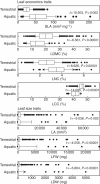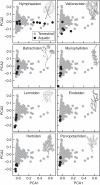Combined use of leaf size and economics traits allows direct comparison of hydrophyte and terrestrial herbaceous adaptive strategies
- PMID: 22337079
- PMCID: PMC3310502
- DOI: 10.1093/aob/mcs021
Combined use of leaf size and economics traits allows direct comparison of hydrophyte and terrestrial herbaceous adaptive strategies
Abstract
Background and aims: Hydrophytes generally exhibit highly acquisitive leaf economics. However, a range of growth forms is evident, from small, free-floating and rapidly growing Lemniden to large, broad-leaved Nymphaeiden, denoting variability in adaptive strategies. Traits used to classify adaptive strategies in terrestrial species, such as canopy height, are not applicable to hydrophytes. We hypothesize that hydrophyte leaf size traits and economics exhibit sufficient overlap with terrestrial species to allow a common classification of plant functional types, sensu Grime's CSR theory.
Methods: Leaf morpho-functional traits were measured for 61 species from 47 water bodies in lowland continental, sub-alpine and alpine bioclimatic zones in southern Europe and compared against the full leaf economics spectrum and leaf size range of terrestrial herbs, and between hydrophyte growth forms.
Key results: Hydrophytes differed in the ranges and mean values of traits compared with herbs, but principal components analysis (PCA) demonstrated that both groups shared axes of trait variability: PCA1 encompassed size variation (area and mass), and PCA2 ranged from relatively dense, carbon-rich leaves to nitrogen-rich leaves of high specific leaf area (SLA). Most growth forms exhibited trait syndromes directly equivalent to herbs classified as R adapted, although Nymphaeiden ranged between C and SR adaptation.
Conclusions: Our findings support the hypothesis that hydrophyte adaptive strategy variation reflects fundamental trade-offs in economics and size that govern all plants, and that hydrophyte adaptive strategies can be directly compared with terrestrial species by combining leaf economics and size traits.
Figures



Similar articles
-
Abundance-weighted plant functional trait variation differs between terrestrial and wetland habitats along wide climatic gradients.Sci China Life Sci. 2021 Apr;64(4):593-605. doi: 10.1007/s11427-020-1766-1. Epub 2020 Sep 21. Sci China Life Sci. 2021. PMID: 32975721
-
Trade-offs between seed and leaf size (seed-phytomer-leaf theory): functional glue linking regenerative with life history strategies … and taxonomy with ecology?Ann Bot. 2017 Nov 10;120(5):633-652. doi: 10.1093/aob/mcx084. Ann Bot. 2017. PMID: 28961937 Free PMC article.
-
Ontogeny strongly and differentially alters leaf economic and other key traits in three diverse Helianthus species.J Exp Bot. 2013 Oct;64(13):4089-99. doi: 10.1093/jxb/ert249. Epub 2013 Sep 28. J Exp Bot. 2013. PMID: 24078673
-
A worldwide analysis of within-canopy variations in leaf structural, chemical and physiological traits across plant functional types.New Phytol. 2015 Feb;205(3):973-993. doi: 10.1111/nph.13096. Epub 2014 Oct 16. New Phytol. 2015. PMID: 25318596 Free PMC article. Review.
-
Diving into the Water: Amphibious Plants as a Model for Investigating Plant Adaptations to Aquatic Environments.Annu Rev Plant Biol. 2024 Jul;75(1):579-604. doi: 10.1146/annurev-arplant-062923-024919. Epub 2024 Jul 2. Annu Rev Plant Biol. 2024. PMID: 38424069 Review.
Cited by
-
Abundance-weighted plant functional trait variation differs between terrestrial and wetland habitats along wide climatic gradients.Sci China Life Sci. 2021 Apr;64(4):593-605. doi: 10.1007/s11427-020-1766-1. Epub 2020 Sep 21. Sci China Life Sci. 2021. PMID: 32975721
-
Leaf reflectance can surrogate foliar economics better than physiological traits across macrophyte species.Plant Methods. 2021 Nov 10;17(1):115. doi: 10.1186/s13007-021-00816-4. Plant Methods. 2021. PMID: 34758853 Free PMC article.
-
Climatic and soil factors explain the two-dimensional spectrum of global plant trait variation.Nat Ecol Evol. 2022 Jan;6(1):36-50. doi: 10.1038/s41559-021-01616-8. Epub 2021 Dec 23. Nat Ecol Evol. 2022. PMID: 34949824 Free PMC article.
-
Functional macrophyte trait variation as a response to the source of inorganic carbon acquisition.PeerJ. 2021 Dec 1;9:e12584. doi: 10.7717/peerj.12584. eCollection 2021. PeerJ. 2021. PMID: 34917426 Free PMC article.
-
Convergent relationships between flower economics and hydraulic traits across aquatic and terrestrial herbaceous plants.Plant Divers. 2023 Jan 24;45(5):601-610. doi: 10.1016/j.pld.2023.01.006. eCollection 2023 Sep. Plant Divers. 2023. PMID: 37936818 Free PMC article.
References
-
- Bornette G, Tabacchi E, Hupp C, Puijalon S, Rostan JC. A model of plant strategies in fluvial hydrosystems. Freshwater Biology. 2008;53:1692–1705.
-
- Britton NL, Brown A. An illustrated flora of the northern United States, Canada and the British Possessions. New York: Charles Scribner's Sons; 1913.
-
- Caccianiga M, Luzzaro A, Pierce S, Ceriani RM, Cerabolini B. The functional basis of a primary succession resolved by CSR classification. Oikos. 2006;112:10–20.
-
- Cerabolini BEL, Brusa G, Ceriani RM, De Andreis R, Luzzaro A, Pierce S. Can CSR classification be generally applied outside Britain? Plant Ecology. 2010a;210:253–261.
-
- Cerabolini B, Pierce S, Luzzaro A, Ossola A. Species evenness affects ecosystem processes in situ via diversity in the adaptive strategies of dominant species. Plant Ecology. 2010b;207:333–345.
Publication types
MeSH terms
Substances
LinkOut - more resources
Full Text Sources
Research Materials

